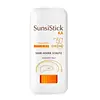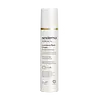What's inside
What's inside
 Key Ingredients
Key Ingredients

 Benefits
Benefits

 Concerns
Concerns

 Ingredients Side-by-side
Ingredients Side-by-side

Octyldodecanol
EmollientPolyethylene
AbrasiveButylene Glycol Cocoate
EmulsifyingHydrogenated Microcrystalline Wax
Emulsion StabilisingBis-Ethylhexyloxyphenol Methoxyphenyl Triazine
Skin ConditioningDiethylamino Hydroxybenzoyl Hexyl Benzoate
UV FilterDiethylhexyl Butamido Triazone
UV AbsorberButyl Methoxydibenzoylmethane
UV AbsorberEthylhexyl Salicylate
UV AbsorberBeeswax
Emulsion StabilisingHydrogenated Castor Oil
EmollientWater
Skin Conditioning1,2-Hexanediol
Skin ConditioningAluminum Hydroxide
EmollientButylene Glycol
HumectantCaprylic/Capric Triglyceride
MaskingCaprylyl Glycol
EmollientCichorium Intybus Root Extract
MaskingDisodium Stearoyl Glutamate
CleansingMethyl Methacrylate Crosspolymer
Oxothiazolidine
Skin ProtectingSaccharin
MaskingSodium Benzoate
MaskingCI 77891
Cosmetic ColorantTocopheryl Glucoside
EmollientOctyldodecanol, Polyethylene, Butylene Glycol Cocoate, Hydrogenated Microcrystalline Wax, Bis-Ethylhexyloxyphenol Methoxyphenyl Triazine, Diethylamino Hydroxybenzoyl Hexyl Benzoate, Diethylhexyl Butamido Triazone, Butyl Methoxydibenzoylmethane, Ethylhexyl Salicylate, Beeswax, Hydrogenated Castor Oil, Water, 1,2-Hexanediol, Aluminum Hydroxide, Butylene Glycol, Caprylic/Capric Triglyceride, Caprylyl Glycol, Cichorium Intybus Root Extract, Disodium Stearoyl Glutamate, Methyl Methacrylate Crosspolymer, Oxothiazolidine, Saccharin, Sodium Benzoate, CI 77891, Tocopheryl Glucoside
Water
Skin ConditioningEthylhexyl Methoxycinnamate
UV AbsorberButylene Glycol
HumectantPropylene Glycol
HumectantEthylhexyl Triazone
UV AbsorberEthylhexyl Salicylate
UV AbsorberCyclopentasiloxane
EmollientBis-Ethylhexyloxyphenol Methoxyphenyl Triazine
Skin ConditioningButyl Methoxydibenzoylmethane
UV AbsorberPolymethyl Methacrylate
Bis-PEG-18 Methyl Ether Dimethyl Silane
EmollientBellis Perennis Flower Extract
Skin ConditioningMica
Cosmetic ColorantIsostearyl Alcohol
EmollientTitanium Dioxide
Cosmetic ColorantAcrylates/C10-30 Alkyl Acrylate Crosspolymer
Emulsion StabilisingNicotiana Benthamiana Hexapeptide-40 Sh-Polypeptide-2
Skin Conditioning3-O-Ethyl Ascorbic Acid
Skin Conditioning4-Butylresorcinol
AntioxidantAlcohol
AntimicrobialAlcohol Denat.
AntimicrobialAscorbyl Palmitate
AntioxidantAzelaic Acid
BufferingBHT
AntioxidantButylene Glycol Cocoate
EmulsifyingCaprylic/Capric Triglyceride
MaskingCaprylyl Glycol
EmollientCarbomer
Emulsion StabilisingCitric Acid
BufferingDecyl Glucoside
CleansingDiacetyl Boldine
Skin ConditioningDimethicone
EmollientDipotassium Phosphate
BufferingDisodium EDTA
Disodium Phosphate
BufferingEthylcellulose
Ethylhexylglycerin
Skin ConditioningGlycerin
HumectantGlyceryl Oleate
EmollientGlyceryl Stearate
EmollientHexylene Glycol
EmulsifyingLecithin
EmollientMelissa Officinalis Leaf Extract
Skin ConditioningParfum
MaskingPhenethyl Alcohol
MaskingPhenoxyethanol
PreservativePolysilicone-11
Polysorbate 20
EmulsifyingPotassium Phosphate
BufferingSilica
AbrasiveSodium Chloride
MaskingSodium Cholate
Skin ConditioningSodium Hydroxide
BufferingTocopherol
AntioxidantTranexamic Acid
AstringentUndecylenoyl Phenylalanine
Skin ConditioningWater, Ethylhexyl Methoxycinnamate, Butylene Glycol, Propylene Glycol, Ethylhexyl Triazone, Ethylhexyl Salicylate, Cyclopentasiloxane, Bis-Ethylhexyloxyphenol Methoxyphenyl Triazine, Butyl Methoxydibenzoylmethane, Polymethyl Methacrylate, Bis-PEG-18 Methyl Ether Dimethyl Silane, Bellis Perennis Flower Extract, Mica, Isostearyl Alcohol, Titanium Dioxide, Acrylates/C10-30 Alkyl Acrylate Crosspolymer, Nicotiana Benthamiana Hexapeptide-40 Sh-Polypeptide-2, 3-O-Ethyl Ascorbic Acid, 4-Butylresorcinol, Alcohol, Alcohol Denat., Ascorbyl Palmitate, Azelaic Acid, BHT, Butylene Glycol Cocoate, Caprylic/Capric Triglyceride, Caprylyl Glycol, Carbomer, Citric Acid, Decyl Glucoside, Diacetyl Boldine, Dimethicone, Dipotassium Phosphate, Disodium EDTA, Disodium Phosphate, Ethylcellulose, Ethylhexylglycerin, Glycerin, Glyceryl Oleate, Glyceryl Stearate, Hexylene Glycol, Lecithin, Melissa Officinalis Leaf Extract, Parfum, Phenethyl Alcohol, Phenoxyethanol, Polysilicone-11, Polysorbate 20, Potassium Phosphate, Silica, Sodium Chloride, Sodium Cholate, Sodium Hydroxide, Tocopherol, Tranexamic Acid, Undecylenoyl Phenylalanine
 Reviews
Reviews

Ingredients Explained
These ingredients are found in both products.
Ingredients higher up in an ingredient list are typically present in a larger amount.
You might know this ingredient as Tinosorb S or Bemotrizinol. It is a UV filter that covers both UVA and UVB rays.
This ingredient has two peak UV absorption peaks ( 310 and 340 nm) and is able to absorb both UV-A and UV-B rays. This ingredient works by preventing UV rays from reaching and damaging your skin.
On top of that - it is highly photostable and helps prevent the photodegration of other sunscreen ingredients such as avobenzone.
Tinosorb S is allowed in the EU, Australia, and Asia. It is close to being approved by the FDA and we'll hopefully get this ingredient in the U.S. by late 2025.
Fun fact: Tinosorb S is the most effective UV absorber at maximum concentration (measured by SPF) permitted in the EU.
This ingredient is oil-soluble, so your oil-cleansers will take this right off at night.
Learn more about Bis-Ethylhexyloxyphenol Methoxyphenyl TriazineAlso known as Avobenzone, this ingredient is a chemical sunscreen filter that provides protection in the UV-A range.
Avobenzone is globally approved and is the most commonly used UV-A filter in the world.
Studies have found that avobenzone becomes ineffective when exposed to UV light (it is not photostable; meaning that it breaks down in sunlight). Because of this, formulations that include avobenzone will usually contain stabilizers such as octocrylene.
However, some modern formulations (looking at you, EU!) are able to stabilize avobenzone by coating the molecules.
Avobenzone does not protect against the UV-B range, so it's important to check that the sunscreen you're using contains other UV filters that do!
The highest concentration of avobenzone permitted is 3% in the US, and 5% in the EU.
Learn more about Butyl MethoxydibenzoylmethaneButylene Glycol (or BG) is used within cosmetic products for a few different reasons:
Overall, Butylene Glycol is a safe and well-rounded ingredient that works well with other ingredients.
Though this ingredient works well with most skin types, some people with sensitive skin may experience a reaction such as allergic rashes, closed comedones, or itchiness.
Learn more about Butylene GlycolButylene Glycol Cocoate isn't fungal acne safe. It can be bad for dry skin.
This ingredient is an emollient, solvent, and texture enhancer. It is considered a skin-softener by helping the skin prevent moisture loss.
It helps thicken a product's formula and makes it easier to spread by dissolving clumping compounds.
Caprylic Triglyceride is made by combining glycerin with coconut oil, forming a clear liquid.
While there is an assumption Caprylic Triglyceride can clog pores due to it being derived from coconut oil, there is no research supporting this.
Learn more about Caprylic/Capric TriglycerideCaprylyl Glycol is a humectant and emollient, meaning it attracts and preserves moisture.
It is a common ingredient in many products, especially those designed to hydrate skin. The primary benefits are retaining moisture, skin softening, and promoting a healthy skin barrier.
Though Caprylyl Glycol is an alcohol derived from fatty acids, it is not the kind that can dry out skin.
This ingredient is also used as a preservative to extend the life of products. It has slight antimicrobial properties.
Learn more about Caprylyl GlycolEthylhexyl Salicylate is an organic compound used to block UV rays. It primarily absorbs UVB rays but offers a small amount of UVA protection as well.
Commonly found in sunscreens, Ethylhexyl Salicylate is created from salicylic acid and 2-ethylhexanol. You might know salicylic acid as the effective acne fighter ingredient and BHA.
The ethylhexanol in this ingredient is a fatty alcohol and helps hydrate your skin, similar to oils. It is an emollient, which means it traps moisture into the skin.
According to manufacturers, Ethylhexyl Salicylate absorbs UV wavelength of 295-315 nm, with a peak absorption at 307-310 nm. UVA rays are linked to long term skin damage, such as hyperpigmentation. UVB rays emit more energy and are capable of damaging our DNA. UVB rays cause sunburn.
Learn more about Ethylhexyl SalicylateWater. It's the most common cosmetic ingredient of all. You'll usually see it at the top of ingredient lists, meaning that it makes up the largest part of the product.
So why is it so popular? Water most often acts as a solvent - this means that it helps dissolve other ingredients into the formulation.
You'll also recognize water as that liquid we all need to stay alive. If you see this, drink a glass of water. Stay hydrated!
Learn more about Water